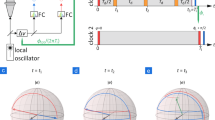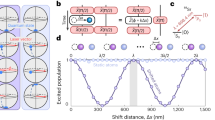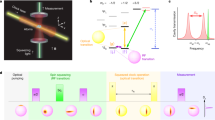Abstract
Atomic clocks based on optical transitions are the most stable, and therefore precise, timekeepers available. These clocks operate by alternating intervals of atomic interrogation with the ‘dead’ time required for quantum state preparation and readout. This non-continuous interrogation of the atom system results in the Dick effect, an aliasing of frequency noise from the laser interrogating the atomic transition1,2. Despite recent advances in optical clock stability that have been achieved by improving laser coherence, the Dick effect has continually limited the performance of optical clocks. Here we implement a robust solution to overcome this limitation: a zero-dead-time optical clock that is based on the interleaved interrogation of two cold-atom ensembles3. This clock exhibits vanishingly small Dick noise, thereby achieving an unprecedented fractional frequency instability assessed to be  for an averaging time τ in seconds. We also consider alternate dual-atom-ensemble schemes to extend laser coherence and reduce the standard quantum limit of clock stability, achieving a spectroscopy line quality factor of Q > 4 × 1015.
for an averaging time τ in seconds. We also consider alternate dual-atom-ensemble schemes to extend laser coherence and reduce the standard quantum limit of clock stability, achieving a spectroscopy line quality factor of Q > 4 × 1015.
This is a preview of subscription content, access via your institution
Access options
Subscribe to this journal
Receive 12 print issues and online access
$209.00 per year
only $17.42 per issue
Buy this article
- Purchase on Springer Link
- Instant access to full article PDF
Prices may be subject to local taxes which are calculated during checkout




Similar content being viewed by others
References
Dick, G. J. Local oscillator induced instabilities in trapped ion frequency standards. In Proc. Precise Time and Time Interval Meeting (ed. Sydnor, R. L.) 133–147 (US Naval Observatory, 1987).
Santarelli, G. et al. Frequency stability degradation of an oscillator slaved to a periodically interrogated atomic resonator. IEEE Trans. Ultra. Ferro. Freq. Cont. 45, 887–894 (1998).
Dick, G. J., Prestage, J. D., Greenhall, C. A. & Maleki, L. Local oscillator induced degradation of medium-term stability in passive atomic frequency standards. In Proc. 22nd Precise Time and Time Interval Meeting (ed. Sydnor, R. L.) 487–508 (NASA, 1990).
Ludlow, A. D., Boyd, M. M., Ye, J., Peik, E. & Schmidt, P. O. Optical atomic clocks. Rev. Mod. Phys. 87, 637–701 (2015).
Poli, N., Oates, C. W., Gill, P. & Tino, G. M. Optical atomic clocks. Riv. Nuovo Cimento 36, 555–624 (2013).
Itano, W. M. et al. Quantum projection noise-population fluctuations in 2-level systems. Phys. Rev. A 47, 3554–3570 (1993).
Chou, C. W., Hume, D. B., Rosenband, T. & Wineland, D. J. Optical clocks and relativity. Science 329, 1630–1633 (2010).
Derevianko, A. & Pospelov, M. Hunting for topological dark matter with atomic clocks. Nat. Phys. 10, 933–936 (2014).
Arvanitaki, A., Huang, J. & Van Tilburg, K. Searching for dilation dark matter with atomic clocks. Phys. Rev. D 91, 015015 (2015).
Jiang, Y. Y. et al. Making optical atomic clocks more stable with 10−16-level laser stabilization. Nat. Photonics 5, 158–161 (2011).
Hinkley, N. et al. An atomic clock with 10−18 instability. Science 341, 1215–1218 (2013).
Nicholson, T. L. et al. Systematic evaluation of an atomic clock at 2×10−18 total uncertainty. Nat. Commun. 6, 6896 (2015).
Häfner, S. et al. 8×10−17 fractional laser frequency instability with a long room-temperature cavity. Opt. Lett. 40, 2112–2115 (2015).
Al-Masoudi, A., Dörscher, S., Häfner, S., Sterr, U. & Lisdat, C. Noise and instability of an optical lattice clock. Phys. Rev. A 92, 063814 (2015).
Nemitz, N. et al. Frequency ratio of Yb and Sr clocks with 5×10−17 uncertainty at 150 seconds averaging time. Nat. Photonics 10, 258–261 (2016).
Takamoto, M., Takano, T. & Katori, H. Frequency comparison of optical lattice clocks beyond the Dick limit. Nat. Photonics 5, 288–292 (2011).
Cole, G. D., Zhang, W., Martin, M. J., Ye, J. & Aspelmeyer, M. Tenfold reduction of Brownian noise in optical interferometry. Nat. Photonics 7, 644–650 (2013).
Harry, G. M. et al. Titania-doped tantala/silica coatings for gravitational-wave detection. Classical Quant. Grav. 24, 405–415 (2007).
Kessler, T. et al. A sub-40-mHz-linewidth laser based on a silicon single-crystal optical cavity. Nat. Photonics 6, 687–692 (2012).
Poli, N. et al. A transportable strontium optical lattice clock. Appl. Phys. B 117, 1107–1116 (2014).
Bondarescu, R. et al. Ground-based optical atomic clocks as a tool to monitor vertical surface motion. Geophys. J. Int. 191, 1770–1774 (2015).
Lisdat, C. et al. A clock network for geodesy and fundamental science. Nat. Commun. 7, 12443 (2016).
Schiller, S. et al. Einstein gravity explorer–a medium-class fundamental physics mission. Exp. Astron. 23, 573–610 (2009).
Westergaard, P. G., Lodewyck, J. & Lemonde, P. Minimizing the Dick effect in an optical lattice clock. IEEE Trans. Ultra. Ferro. Freq. Cont. 57, 623–628 (2010).
Biedermann, G. W. et al. Zero-dead-time operation of interleaved atomic clocks. Phys. Rev. Lett. 111, 170802 (2013).
Kohlhaas, R. et al. Phase locking a clock oscillator to a coherent atomic ensemble. Phys. Rev. X 5, 021011 (2015).
Borregaard, J. & Sørenson, A. S. Efficient atomic clocks operated with several atomic ensembles. Phys. Rev. Lett. 111, 090802 (2013).
Wineland, D. J., Bollinger, J. J., Itano, W. M., Moore, F. L. & Heinzen, D. J. Spin squeezing and reduced quantum noise in spectroscopy. Phys. Rev. A 46, R6797–R6800 (1992).
Leroux, I. D., Schleier-Smith, M. H. & Vuletić, V. Implementation of cavity squeezing of a collective atomic spin. Phys. Rev. Lett. 104, 073602 (2010).
Oates, C. W., Bondu, F., Fox, R. W. & Hollberg, L. A diode-laser optical frequency standard based on laser-cooled Ca atoms: sub-kilohertz spectroscopy by optical shelving. Eur. J. Phys. D 7, 449–460 (1999).
Dicke, R. H. The effect of collisions upon the Doppler width of spectral lines. Phys. Rev. 89, 472–473 (1953).
Nagourney, W., Sandberg, J. & Dehmelt, H. Shelved optical electron amplifier: observation of quantum jumps. Phys. Rev. Lett. 56, 2797–2799 (1986).
Sauter, Th., Neuhauser, W., Blatt, R. & Toschek, P. E. Observation of quantum jumps. Phys. Rev. Lett. 57, 1696–1698 (1986).
Bergquist, J. C., Hulet, R. G., Itano, W. M. & Wineland, D. J. Observation of quantum jumps in a single atom. Phys. Rev. Lett. 57, 1699–1702 (1986).
Ye, J., Kimble, H. J. & Katori, H. Quantum state engineering and precision metrology using state-insensitive light traps. Science 320, 1734–1738 (2008).
Katori, H., Takamoto, M., Pal'chikov, V. G. & Ovsiannikov, V. D. Ultrastable optical clock with neutral atoms in an engineered light shift trap. Phys. Rev. Lett. 91, 173005 (2003).
Meunier, M. et al. Stability enhancement by joint phase measurements in a single cold atomic fountain. Phys. Rev. A 90, 063633 (2014).
Ma, L. S., Jungner, P., Ye, J. & Hall, J. L. Delivering the same optical frequency at 2 places - accurate cancellation of phase noise introduced by an optical-fiber or other time-varying path. Opt. Lett. 19, 1777–1779 (1994).
Falke, S., Misera, M., Sterr, U. & Lisdat, C. Delivering pulsed and phase stable light to atoms of an optical clock. Appl. Phys. B 107, 301–311 (2012).
Acknowledgements
The authors acknowledge the Defense Advanced Research Projects Agency (DARPA) Quantum Assisted Sensing and Readout (QuASAR) programme, the NASA Fundamental Physics programme and the National Institute of Standards and Technology for financial support. R.C.B. acknowledges support from the National Research Council Research Associateship programme. We also thank T. Fortier, F. Quinlan and S. Diddams for femtosecond optical frequency comb measurements.
Author information
Authors and Affiliations
Contributions
M.S., R.C.B., W.F.M., R.J.F., G.M., D.N. and A.D.L. carried out the instability measurements. M.S. and A.D.L. constructed the clock laser. W.F.M., T.H.Y and A.D.L. contributed to the optimization of the clock laser performance. J.A.S. constructed the DDS system for precise cavity drift compensation. R.C.B., N.H., T.H.Y., W.F.M., R.J.F., G.M. and A.D.L. were responsible for the operation of Yb-1 and Yb-2 systems and the phase noise cancellation. K.B. contributed to the evaluation of the instability budget. C.W.O. and A.D.L. supervised this work. All authors contributed to the final manuscript.
Corresponding author
Ethics declarations
Competing interests
The authors declare no competing financial interests.
Supplementary information
Supplementary information
Supplementary information (PDF 186 kb)
Rights and permissions
About this article
Cite this article
Schioppo, M., Brown, R., McGrew, W. et al. Ultrastable optical clock with two cold-atom ensembles. Nature Photon 11, 48–52 (2017). https://doi.org/10.1038/nphoton.2016.231
Received:
Accepted:
Published:
Issue Date:
DOI: https://doi.org/10.1038/nphoton.2016.231
This article is cited by
-
A lab-based test of the gravitational redshift with a miniature clock network
Nature Communications (2023)
-
Improved interspecies optical clock comparisons through differential spectroscopy
Nature Physics (2023)
-
A compact, transportable 1550 nm ultra-stable laser system with Hertz linewidth
Applied Physics B (2023)
-
Direct detection of ultralight dark matter bound to the Sun with space quantum sensors
Nature Astronomy (2022)
-
Differential clock comparisons with a multiplexed optical lattice clock
Nature (2022)



